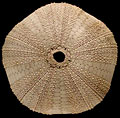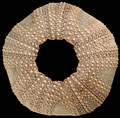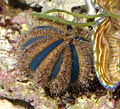The Echinoid Directory
Mespilia Desor, in Agassiz & Desor, 1846, p. 357
| Diagnostic Features |
|
|---|---|
| Distribution | Recent; Indo-West Pacific. |
| Name gender | unknown |
| Type | Echinus globulus Linnaeus, 1758, p. 664, by original designation. |
| Species Included | Only the type. |
| Classification and/or Status |
|
| Remarks |
|




